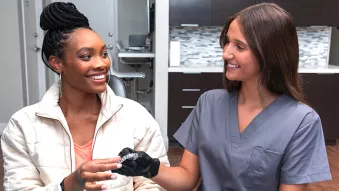How To Keep Your Clear Aligners Clean And Bright During Treatment

If you are thinking about clear aligners or have just started clear aligner therapy, you likely selected this treatment modality for its nearly clear, discreet appearance.. Clear aligner treatment directed by an orthodontist is a very effective and popular approach because it provides a more aesthetic option than traditional metal braces.
But without the proper care, clear aligners can stain and discolor, making the clarity much less desirable for the patient.
As an orthodontist with about 20 years of experience and more than 2000 aligner patients, I wanted to share some practical tips and information so you can select the best aligner product and keep it stain-free to feel your most confident during treatment.
Not All Aligners are Made The Same
Not all aligners are made with the same material, which can make a big difference with how your aligners hold up over time. Spark™ Clear Aligners is a newer aligner system that is clearer and more stain-resistant than other aligner products*— while still being as, or even more, effective in moving teeth. It is made with TruGEN™ material, which has been proven to be more clear and stain-resistant than the leading competitor.*
There are other aligners you can order directly from the manufacturer, which do not involve a doctor or doctor visits in your treatment plan. I do not recommend these devices and treatment protocols because I have unfortunately been asked to correct one too many unhappy patients’ less-than-desirable smiles with some of these products.
How do Aligners Get Stained?
Proper protocol while being treated with aligners is to remove them before eating and drinking. Then, ideally, you would brush your teeth before re-inserting your aligners. They should be worn about 22 hours a day, so basically whenever you are not eating, drinking, or brushing your teeth.
But with today’s busy lifestyles, many patients place their aligners back in their mouth without brushing after eating or drinking.. By not taking the proper care, food and beverage residue can stain the clear plastic, turning it yellow and making it more noticeable during wear.
Any dark-colored food or drink can lead to stains, but here is a shortlist of some of the biggest culprits:
- Nicotine products, including cigarettes, vape products, and smokeless tobacco
- Berries (blueberry, raspberry, strawberry), cherries, or smoothies with these products
- Dark fruit juices (cherry, cranberry, blueberry, raspberry) and colored fruit-flavored drinks, such as Kool-Aid
- Dark, caramel-colored sodas, energy drinks
- Tea and coffee
- Alcoholic drinks such as red wine
- Deep, rich, colored sauces, such as spaghetti sauce and curry
- Hard or sticky dark or neon-colored candies
Tips for Avoiding Staining
The best way to avoid stained aligners is to eliminate the behaviors that cause them in the first place. Instead, you should be sure that you:
- Do not drink or eat with your aligners in your mouth.
- Use a straw to drink dark beverages to reduce staining of your teeth (such as iced tea or coffee, dark juices, dark soda, etc.) with your aligners out.
- Brush your teeth after eating or drinking before re-inserting your aligners.
Tips for Keeping Your Aligners Sparkling Clean
Some of the frequent questions I get include: “How do you clean stained aligners?" or “What are the best ways to remove stains from aligners?”
Just as good oral hygiene is important for your teeth, it is also good for your aligners. But do not treat your aligners like they are your teeth. Toothpaste can be too abrasive for use on aligners, and can make little scratches on them. This can cause them to become less translucent and more opaque or noticeable. Instead, here are some safe ways to clean and remove stains from aligners:
- Regularly wash your aligners with soap and water, and thoroughly rinse.
- Brush your aligners with a soft bristle toothbrush
- Do not soak aligners in a heavy solution overnight for an extended period, or using boiling water. You should also avoid using toothpaste, which may have some abrasive crystals that could impact the clarity of your aligners.
Other Questions I Get Asked
When patients have an aligner that has started yellowing, they will usually ask me if they can go back to a previous aligner or advance to their next one. Unfortunately, old aligners are not an option, as this will cause the teeth to move back to the position of that aligner. Old aligners should be properly disposed of after their usage period. Similarly, patients should not advance to their next aligner unless their doctor says they can do so. Advancing too quickly means that your teeth may not have had enough time to move to the desired position directed by your current aligner. By inserting the next aligner you may experience discomfort as the movement may be too much too soon.
I also get asked regularly if drinking dark beverages such as coffee through a straw prevents aligners from getting stained. As, indicated earlier, consuming beverages is best done after removing your aligners to keep them sparkling clean and clear. But if you are going to consume a dark beverage with your aligners in, it is better to use a straw than not.
I also get questions from patients who ask me how to whiten aligners after staining has occurred or if they can use their aligners to whiten their teeth during aligner therapy. My advice is that no one should try to whiten any aligner. The integrity of the material used to gently move teeth into the desired position may be compromised with any bleaching or teeth-whitening products. I also do not recommend whitening your teeth during treatment as teeth during treatment are already sensitive due to their constant state of movement. For patients with teeth stains, using a teeth-whitening process once aligner treatment is completed might yield the best reward for the entire process — straight, beautiful, white teeth.
Spark Clear Aligners wants to provide you with the best care possible. Find a spark provider near you and get started on a happier, healthier smile today!



